How to Navigate Enterprise Social Media Management for Effective Growth?
Discover key insights on how to effectively handle enterprise social media and how to properly measure results to evaluate the success of your strategy.


Managing social media at an enterprise level is about far more than maintaining a presence on multiple platforms. It’s about navigating an intricate network of global markets, diverse audiences, regulatory requirements, and high-stakes business goals — all while delivering measurable results. The scale changes everything: content approval chains span continents, analytics must connect to revenue impact, and tools need to integrate seamlessly with enterprise tech stacks.
Join me further to explore the strategies, features, and tools that allow enterprise teams to take control of this complexity and turn it into a scalable, measurable advantage.
Key takeaways
-
What are the specifics of social media management at an enterprise level? Enterprise social media management requires navigating complex structures, global markets, and compliance demands while delivering measurable business results at scale.
-
When to use multiple platforms vs. all-in-one solutions? Choosing between multiple specialized tools and an all-in-one platform depends on your organization’s need for depth versus simplicity in managing complex social operations.
-
What does an enterprise-level social media content strategy imply? An effective enterprise content strategy balances brand consistency, compliance, and scalability while driving measurable impact across diverse markets and audiences.
What are the specifics of social media management at an enterprise level?
Managing social media enterprise operations isn't just about scaling up your regular social efforts. When you're dealing with multinational corporations, complex hierarchies, and millions of dollars in marketing budgets, the specifics of social media management become complicated, to say the least.
Social media enterprise management requires a different approach than small business or mid-market strategies. You're not just managing one brand voice or a single customer journey. You're dealing with interconnected campaigns, various stakeholders, and complex business objectives.
To be able to put order into the hypothetical chaos, you must first understand the nature of the challenges.
Scale-specific challenges
- Managing multiple brands, regions, and business units - Social media enterprise teams often juggle dozens of brands across different markets, each requiring its social media strategy while maintaining corporate consistency across diverse audiences and cultures.
- Coordinating across departments and time zones - Enterprise social media planning involves multiple stakeholders across various departments (marketing, legal, compliance, product, customer service, executive leadership, etc.), often spanning different time zones and approval workflows.
- Content volume and approval bottlenecks - Large organizations generate massive amounts of social media content across multiple platforms and business units. Maintaining quality and brand consistency while managing approval processes becomes challenging.
Regulatory and compliance concerns
- Industry-specific regulations (finance, healthcare, etc.) - Enterprises in regulated industries face additional complexity with SEC regulations for financial services, HIPAA considerations for healthcare, GDPR for data protection in the EU, and other industry-specific compliance requirements that affect social media content creation and engagement.
- Legal approval processes - Enterprise social media content often requires legal review for product claims, promotional offers, or content that could be interpreted as financial or health guidance, for example. Enter additional approval layers that can significantly slow down content pipelines.
ROI and attribution complexities
- Measuring impact across multiple business objectives - Social media enterprise efforts typically support multiple goals simultaneously, such as brand awareness, lead generation, and sales. You typically need to set up sophisticated attribution models and social media reporting that demonstrates value across different business units.
- Attribution in complex customer journeys - Enterprises usually deal with long sales cycles, involving multiple touchpoints across different channels. Traditional social media attribution models are sometimes insufficient for capturing business impact.
- Justifying social media investment to C-suite - Enterprise social media budgets can reach millions of dollars annually, when adding up human resources, tools, ad spend, etc. Social media ROI justification to leadership becomes essential. To keep things (and money) going, you need concrete business outcomes like revenue, customer acquisition costs, and market share growth.
While measuring social media success has historically been tricky, we’re here to help. With Socialinsider's organic value feature, social media managers can now evaluate social media performance and impact beyond engagement and attribute a monetary value to their results. This feature transforms how enterprises justify their social media investment to C-suite executives.
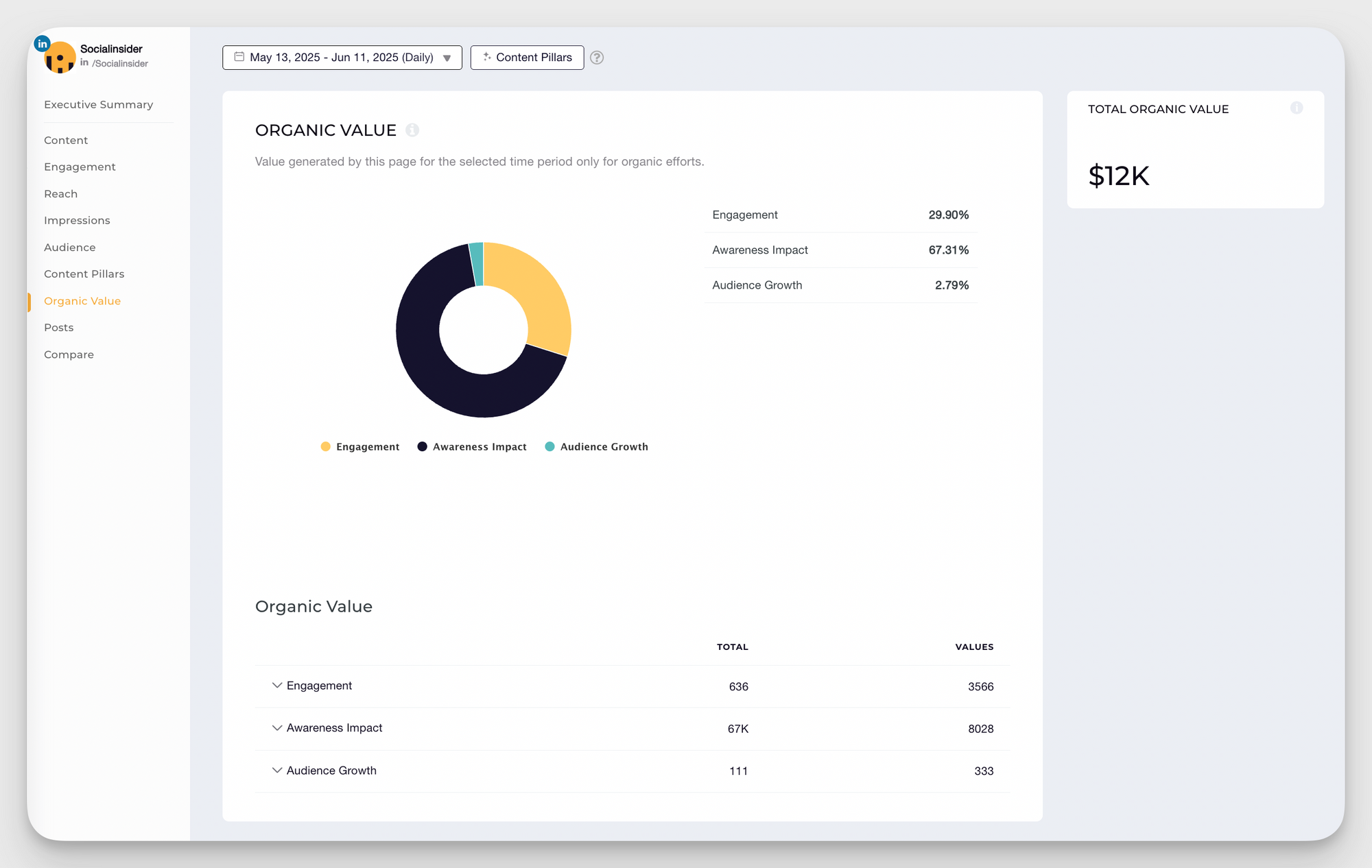
The social media organic value calculation provides concrete financial metrics that resonate with executive stakeholders. Instead of reporting "10,000 likes", you can report "$12,000 in organic value generated", making ROI discussions more meaningful and actionable.
Here’s how to set up organic value tracking in Socialinsider:
- Navigate to your Project Settings and select "Organic Value Configuration".
- Configure platform-specific values for each social media platform your enterprise uses.

- Set specific monetary values for different social media engagement types and awareness metrics based on your enterprise's customer acquisition costs and lifetime value calculations.
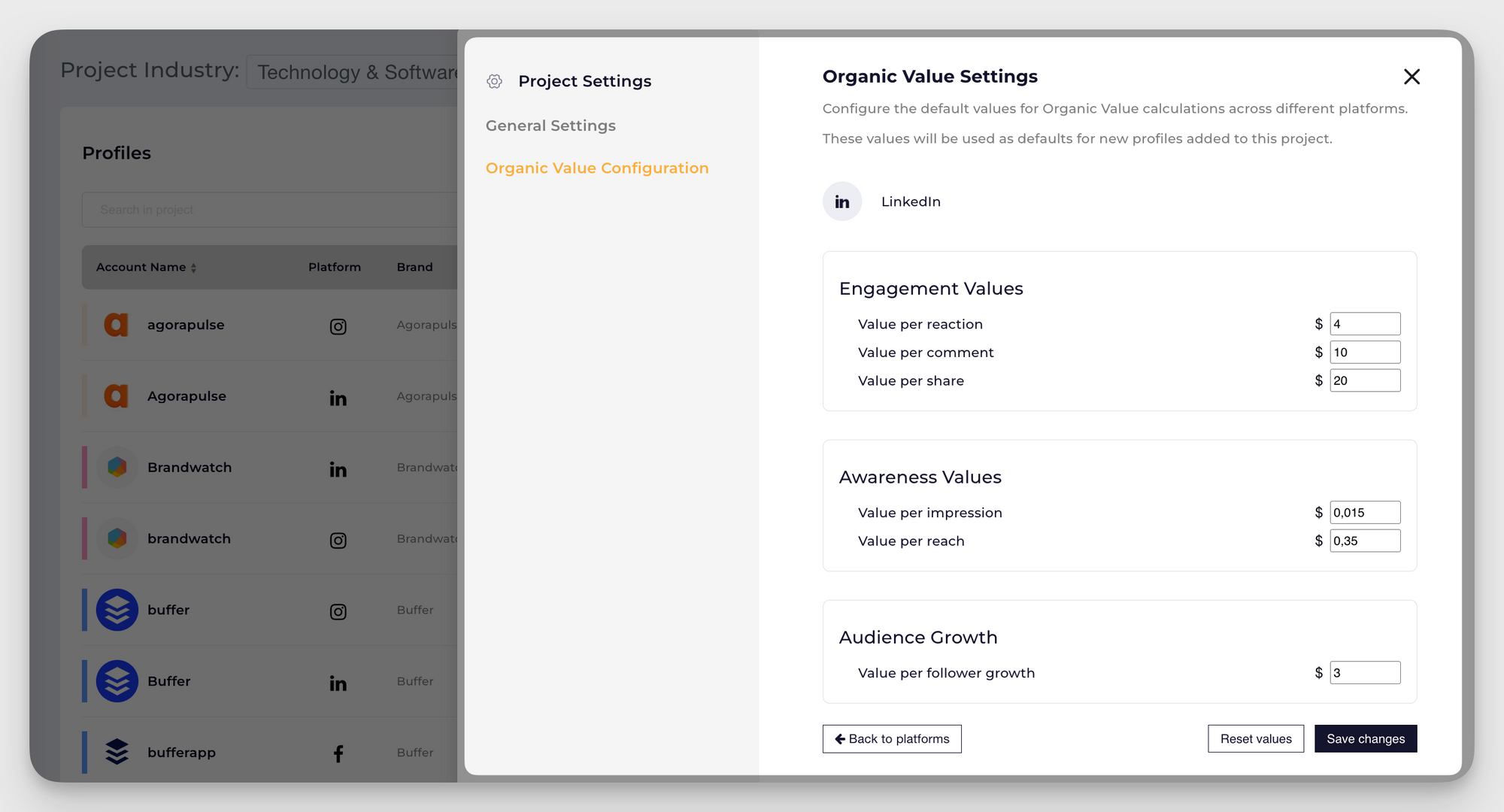
This granular configuration allows enterprise social media teams to align their organic value calculations with actual business metrics, creating more accurate ROI reporting that speaks directly to bottom-line impact.
What are the important features of effective social media management tools for enterprises?
Social media enterprise management tools need to have features that can handle complex organizational structures, security requirements, and reporting needs that go far beyond basic social media management.
Below are a few must-have features, based on our experience working with enterprise teams:
- Multi-account and multi-platform management - Enterprise tools must handle tens or even hundreds of social media accounts across multiple platforms, brands, and regions from a single interface. Your social media team needs to maintain oversight without switching between different tools or dashboards, which is resource draining.
- Role-based permissions and access controls - Different team members need different levels of access based on their roles, departments, and responsibilities. Effective enterprise social media management platforms provide granular permission settings that ensure the right people can access the right accounts and features.
- Multi-level approval workflows - Enterprise social media content often requires multiple approval stages, from content creators to brand managers to legal teams. Your enterprise social media management tool needs customizable workflow automation that can route content through the appropriate approval chains.
- Real-time collaboration features - Social media teams often work across different time zones and departments, requiring real-time collaboration capabilities that allow seamless handoffs, comments, and revisions without losing context or momentum.
- Social media performance KPIs monitoring - Enterprise social media analytics need to track sophisticated social media KPIs that align with business objectives, providing real-time monitoring of performance across all accounts and campaigns.
- Historical posts data - Long-term trend analysis and competitive benchmarking require access to extensive historical data. Your team must be able to identify patterns, track long-term performance trends, and make data-driven decisions about your social media content strategy.
- Cross-platform reporting and data unification - Manually compiling data from different sources almost always leads to errors and missed opportunities. Enterprise reporting needs to consolidate data from multiple platforms into unified reports that provide a complete view of social media performance.
- Competitive analysis and benchmarking - Competitive analysis tools are essential for social media success. Enterprises must be able to accurately understand their market position relative to competitors, identify opportunities, and benchmark their performance against others.
- Industry benchmarks - Social media benchmarks specific to your industry provide context for performance evaluation, help set realistic goals based on industry standards and best practices, and reveal opportunities for growth.
- Advanced attribution and ROI measurement - Enterprise social media management platforms should allow you to use different degrees of sophistication in attribution modeling, depending on how complex customer journeys are. They should also provide clear ROI calculations for executive reporting.
- Custom integrations and API access - Enterprises often need to integrate social media data with CRM systems, marketing automation platforms, and business intelligence tools, requiring robust API access and custom integration capabilities.
- SSO and 2-factor authentication - Enterprise security requirements mandate single sign-on integration with existing identity management systems and multi-factor authentication to protect sensitive social media accounts and data.
Now that we've covered the essential features you need in an enterprise management platform, let's examine the top social media tools that deliver these capabilities.
What are the top social media enterprise tools for managing platforms?
It might be tempting to choose the platform with the most features — after all, you’re dealing with a lot of complexity and use cases, right?
That’s true to some extent. You need features like the ones listed in the previous section. However, don’t focus on features alone, but rather on finding solutions to your organization's specific complexity, scale, and analytical requirements.
While having one magic solution for all needs would be great, the reality is that organizations often need multiple specialized tools working together. Rather than trying to force a single platform to handle every aspect of your social media operations, look for platforms that are very good at handling specific areas and that offer robust integration.
Socialinsider - Social media enterprise data & social media API
Socialinsider stands out as the best choice for enterprises that need advanced social media analytics and comprehensive data analysis capabilities.
Unlike social media management platforms that focus primarily on publishing and basic reporting, Socialinsider specializes in providing the deep analytical insights that companies need for strategic decision-making.
What sets our platform apart is its focus on solving the specific social media data challenges that enterprise teams face daily.
Let’s face it, enterprises are no regular clients. And they’re not just looking for another scheduling tool. They need a platform that can handle massive volumes of data, provide historical insights, allow customization, and deliver the kind of sophisticated reporting that C-suite executives expect.
Here are the enterprise-specific capabilities social media managers love:
- Comprehensive platform analytics - Socialinsider supports analytics for all major social media platforms, including Facebook, Instagram, TikTok, LinkedIn, X (Twitter), and YouTube. For each platform, you can access in-depth analytics, including executive summaries, key insights, and detailed social media metrics, including saves, views, likes, comments, post types, and platform-specific variations.
- Advanced competitor benchmarking - The platform enables sophisticated competitive benchmarking by allowing you to add competitor accounts and analyze public data. Content is automatically categorized into industry-specific content pillars using AI, and you can also create custom pillars to identify top-performing content types and engagement drivers.
- Complete data access for owned accounts - For connected accounts (your pages), you get full access to both organic data, including audience demographics. For competitor accounts, only public and estimated metrics are available due to platform restrictions.
- Multi-account analysis across regions and brands - Socialinsider enables global brands to monitor hundreds of social media profiles simultaneously, providing consolidated insights across different markets, business units, and brand portfolios.
- Historical posts data spanning 24 months - Enterprises require extensive historical social media data for audits, trend analysis, and predictive modeling. Socialinsider provides up to 24 months of historical data for most platforms, giving enterprises the deep historical context needed for meaningful analysis and strategic planning.
- Volume of data management - Enterprise social media analysis involves monitoring industry trends, competitor activities, and internal performance across multiple platforms. Socialinsider aggregates all this data into a single social media dashboard, eliminating the need to switch between different platforms or manually compile reports.
- Robust social media API for data aggregation - Socialinsider's API enables seamless data integration and automated reporting workflows that fit into existing enterprise technology stacks.
- Multi-team member collaboration - Socialinsider supports multiple users with different permission levels, enabling teams to work together effectively while maintaining appropriate oversight and security.
- Data freshness with updates under 2 hours – Real-time social media monitoring is a must for crisis management, campaign optimization, and competitive response. Socialinsider updates data within 2 hours, providing the timely insights needed for agile decision-making.
- Flexible data export and integration - Data can be exported in various formats (CSV, PDF, PowerPoint), and Socialinsider integrates with Google Looker Studio for advanced reporting.
- Scalable enterprise pricing - The enterprise plan is fully scalable. You specify the number of social media profiles you need to analyze, and pricing adjusts accordingly.
Complementary enterprise solution
Most customers who already use social media enterprise solutions such as Sprinklr or Sprout Social choose to add Socialinsider as a complementary tool for advanced analytics. While these platforms excel at content management and publishing, Socialinsider fills the critical gap in deep analytical capabilities that enterprises need for strategic planning and performance optimization.
Book a demo to see how we can transform your enterprise social media analytics.
Brandwatch - For social listening
Brandwatch specializes in social listening and conversation monitoring across the web. It’s a helpful tool for enterprises that need to track brand mentions, industry conversations, and sentiment analysis at scale.
The platform excels at monitoring unstructured social media conversations and providing insights into brand perception and market trends.
Meltwater - For integrated PR and social media intelligence
Meltwater combines traditional PR monitoring with social media intelligence, making it a good fit for enterprises that need to coordinate their social media efforts with broader communications and PR strategies.
The platform provides comprehensive media monitoring across both traditional and social channels.
SparkToro - For audience analysis
SparkToro provides unique audience intelligence capabilities that help enterprises understand where their target audiences spend time online, what content they engage with, and which influencers they follow.
This platform is particularly valuable for enterprises developing social media audience analysis and content strategies.
When to use multiple platforms vs. all-in-one solutions?
We already mentioned that you might need multiple specialized platforms versus a single all-in-one solution. There are various things to consider when making a decision, so let’s discuss them to ease your selection process.
Use multiple platforms when you have:
- Specialized needs - Your enterprise requires best-in-class competitive analysis reports, social listening, and publishing capabilities that no single platform can deliver at the level your organization demands. Different functions often require different depths of specialization.
- Complex organizations - Departments have distinct requirements that no single platform handles well. Your marketing team might need advanced analytics, while your customer service team requires robust social listening, and your content team needs sophisticated publishing workflows.
- Budget flexibility - You can invest in specialized tools for specific high-value functions where excellence in that area justifies the additional complexity and cost of managing multiple vendor relationships.
- Advanced requirements - You need cutting-edge features in areas like competitive intelligence, social media attribution, or industry-specific analytics that all-in-one platforms don't offer due to their broader focus.
Use all-in-one solutions when:
- Simplicity is a priority - Your team or organization prefers a single vendor relationship to get unified training programs and a consistent user experience across all functions.
- Tight integration is a must - You require seamless data flow between publishing, analytics, and reporting without the complexity of managing API connections and data synchronization between multiple platforms.
Core components of an enterprise-level social team
Building an effective enterprise social media team requires more than just hiring people who understand social platforms.
You need a strategic mix of specialists who can handle the complexity and scale of the enterprise social media ecosystem.
The most successful enterprise social media teams organize around three core functional areas, each with distinct skill sets and responsibilities. Here they are below:
Content & creative:
- Social media strategists - Develop content pillars, editorial calendars, and messaging templates that align with business objectives and brand messaging.
- Social media managers - Handle content distribution, community engagement, and day-to-day social media operations. They ensure adherence to brand guidelines and compliance requirements.
- Content creators - Include copywriters, content writers, graphic designers, and video producers. They create high-quality content at the volume and variety required for enterprise-scale social media programs.
- Community managers - Focus on customer service, engagement, and relationship building with existing and potential customers. They are the front line for customer interactions and reputation management.
Analytics & intelligence:
- Social media analysts - Handle performance tracking, reporting, and insights generation. They use tools like Socialinsider to provide actionable intelligence that drives strategic decision-making and campaign optimization.
- Competitive intelligence specialists - Conduct market analysis, competitive benchmarking, and trend identification to keep the organization ahead of industry developments and competitor activities.
- Data analysts - Perform advanced analytics, predictive modeling, and attribution analysis to connect marketing activities with business outcomes and ROI.
Operations & technology:
- Social media operations managers - Oversee workflow optimization and process management. They ensure efficient collaboration between different team members and departments.
- Technology specialists - Handle platform management, integration oversight, and tool administration. They ensure that the enterprise social media technology stack operates smoothly and securely.
- Project managers - Coordinate social media campaign execution, cross-functional collaboration, and timeline management. They ensure that complex initiatives stay on track and deliver results.
What does an enterprise-level social media content strategy imply?
At the enterprise level, you're managing a complex content ecosystem that must maintain brand consistency across markets, comply with various regulatory requirements, and scale efficiently. Oh, and you have to deliver measurable business results on top of everything.
To achieve all that, you need systematic approaches to content planning, governance, and production that enable your team to handle the volume and complexity without delays and bottlenecks.
Enterprise social media content strategy operates on three fundamental levels, each addressing different aspects of the content lifecycle and organizational requirements.
Content framework development
Step one is establishing clear frameworks that guide content creation. These frameworks ensure that, despite the scale and complexity of enterprise operations, every piece of content serves strategic business objectives while maintaining brand integrity.
- Brand voice and messaging consistency - Enterprise teams must maintain unified brand voice across multiple business units, regions, and platforms while allowing for local market adaptations. This requires comprehensive brand guidelines and messaging frameworks that ensure consistency without stifling creativity or local relevance.
- Content pillars and theme development - Strategic content pillars provide the foundation for all social media content creation, ensuring that every piece of content serves specific business objectives while maintaining thematic consistency.
- Editorial calendar planning and execution - Enterprise editorial calendars coordinate content across multiple teams, platforms, and business objectives while accounting for global events, product launches, and seasonal campaigns that affect different markets at different times.
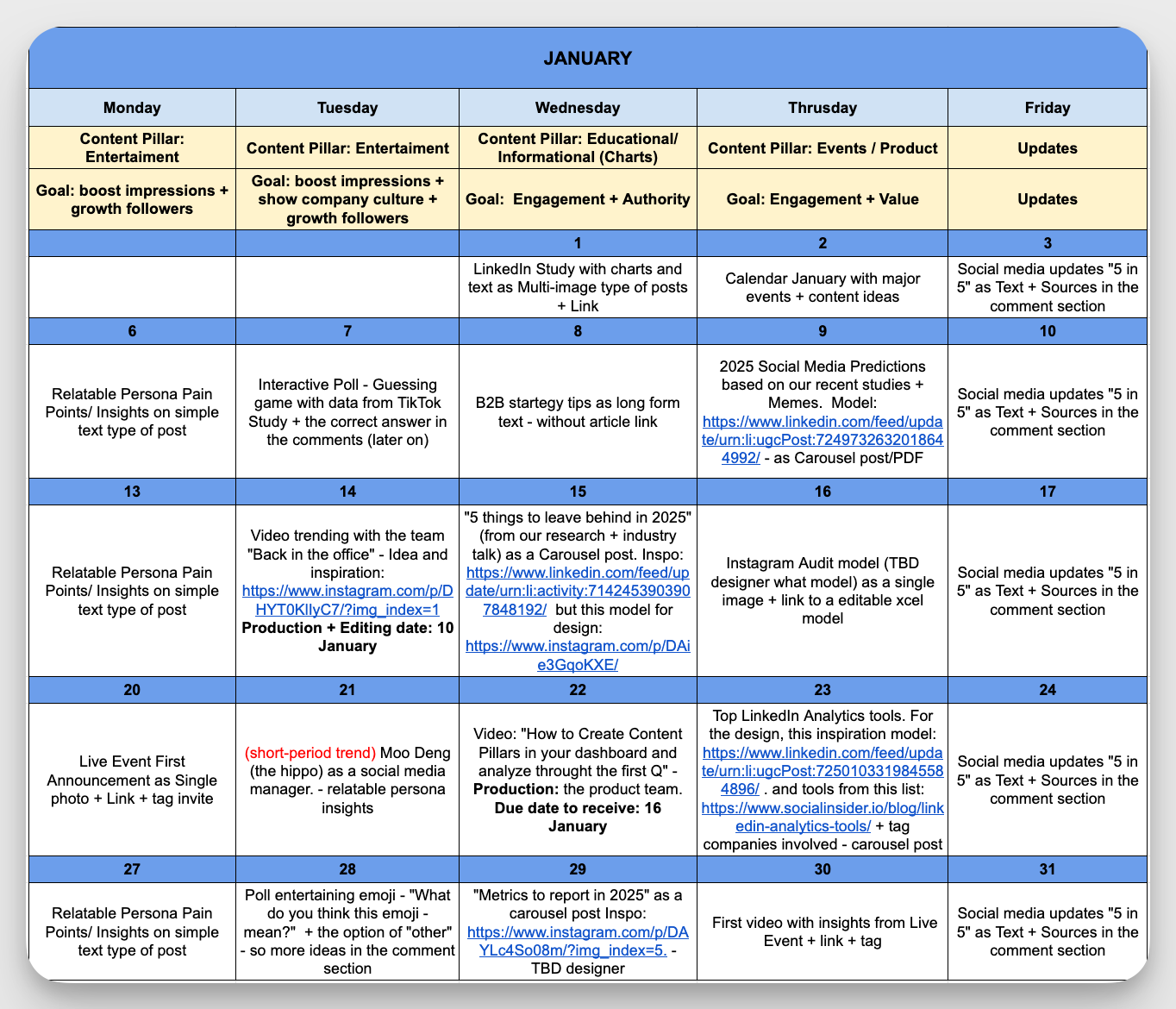
Take the social media planning example above. This editorial calendar shows how you can structure your posts around strategic content pillars while coordinating different content types and objectives throughout the month. Each day is mapped to specific content goals and pillar themes, ensuring consistent messaging while maintaining variety and engagement.
Governance and compliance adherence
Enterprise content strategy also needs governance and compliance structures that ensure content meets legal, regulatory, and organizational standards. These processes protect the organization while enabling confident content publication at scale.
- Content approval hierarchies - Enterprise social media requires multi-level approval processes that balance oversight with operational efficiency. These hierarchies ensure that content meets brand standards, legal requirements, and business objectives before publication.
- Legal and compliance review processes - Regulated industries require additional review layers. These processes must be built into content workflows without creating bottlenecks.
- Crisis communication protocols - Organizations need pre-approved messaging frameworks and rapid response protocols for crises. To protect brand reputation, organisations must be able to react immediately to potential issues across multiple channels and time zones.
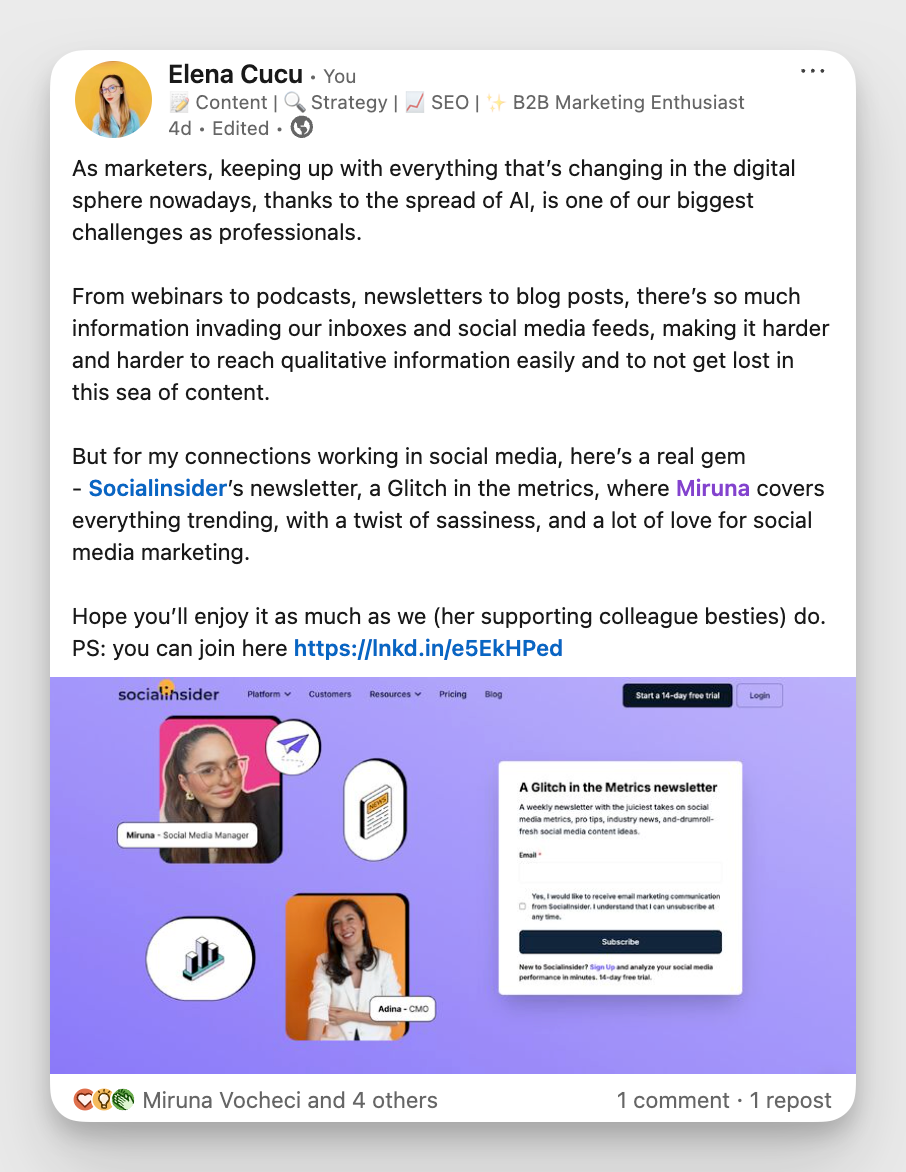
This example from Socialinsider showcases effective employee advocacy in action. The post combines personal voice with branded messaging and visual assets, scaling content reach effectively.
Advanced analytics and performance measurement
While a comprehensive content strategy provides the foundation for enterprise social media success, advanced analytics and performance measurement enable you to optimize that strategy and demonstrate its business value.
Social media measurement must connect social performance to broader business objectives while providing the granular insights needed for optimization.Your team needs access to analytics platforms that can handle massive data volumes, complex attribution models, and multi-channel performance analysis.
In-depth metrics performance across channels
Enterprise analytics must provide comprehensive visibility into performance across all social media channels.
At the same time, you must be able to drill down into specific metrics that matter for business decision-making. This level of detail helps you understand which strategies are working and which need improvement.

Enterprise dashboards must consolidate massive volumes of data into actionable insights, which is not an easy task. This overview from Socialinsider provides executives with immediate visibility into performance scale while enabling deeper analysis of specific metrics that drive business outcomes.
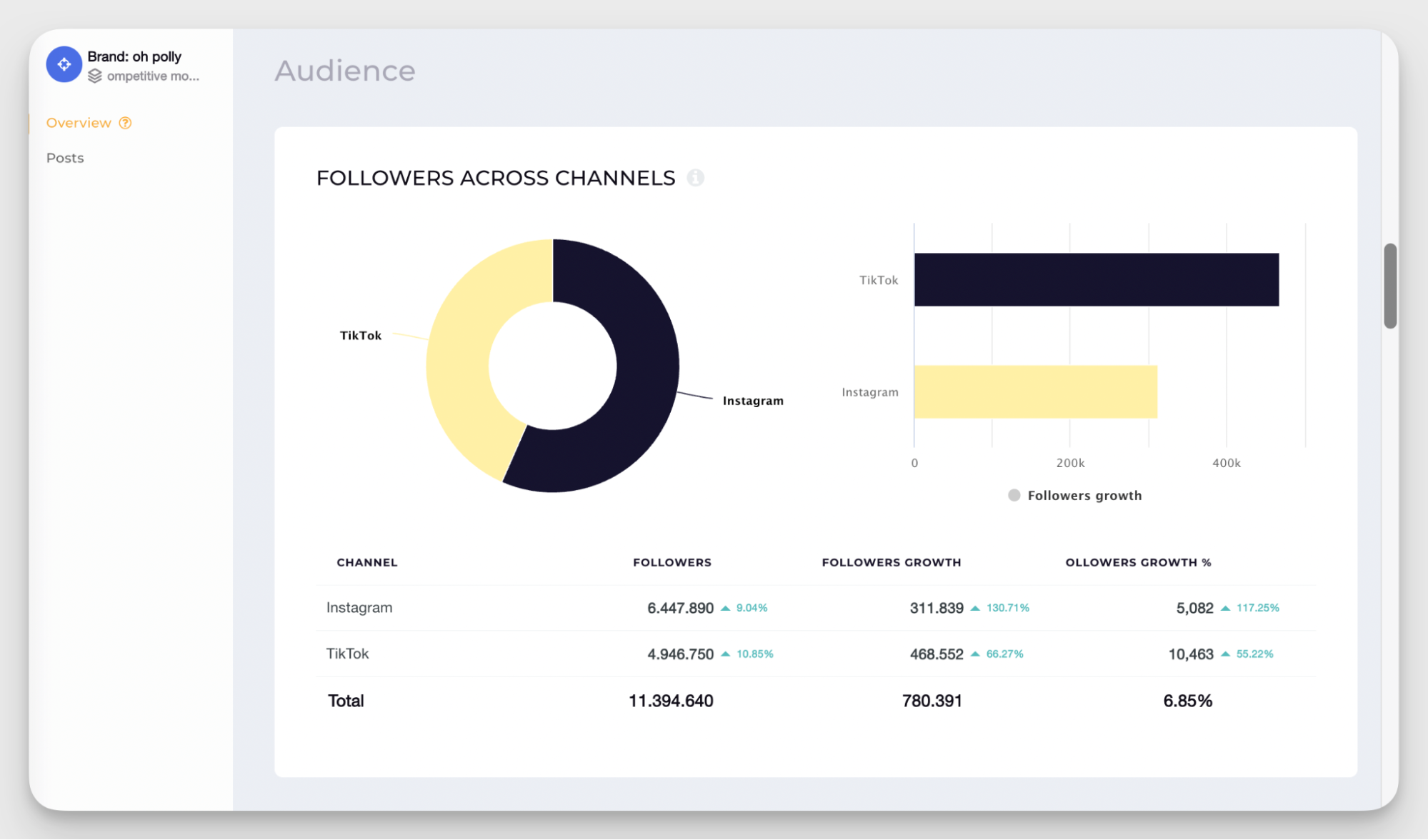
Cross-platform audience analysis reveals how different channels contribute to overall brand reach and growth. The granular view above enables strategic decisions about resource allocation and platform prioritization based on actual performance data.
Competitive intelligence and benchmarking
Competitive insights for enterprises go beyond monitoring individual competitors to understanding industry-wide trends and performance benchmarks. This intelligence informs strategic planning and helps identify market opportunities.
- Setting up competitor monitoring and analysis - Socialinsider offers the possibility to compare performance against direct, selected competitors, but also at an aggregated, industry-level analysis that provides context for your performance relative to market standards.
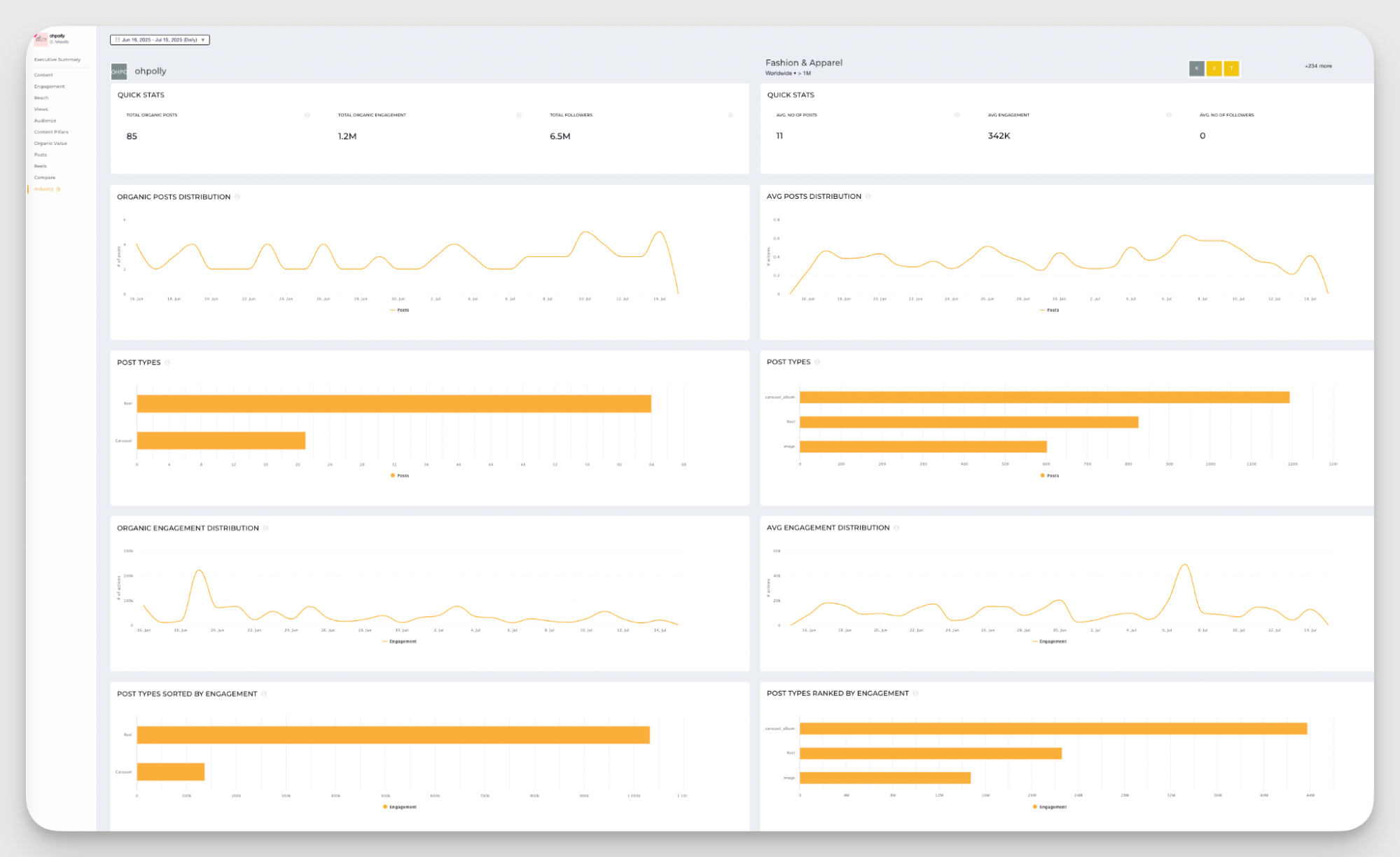
- Industry performance benchmarking strategies - Understanding how your performance compares to industry standards helps set realistic goals and identify areas where you're outperforming or underperforming.
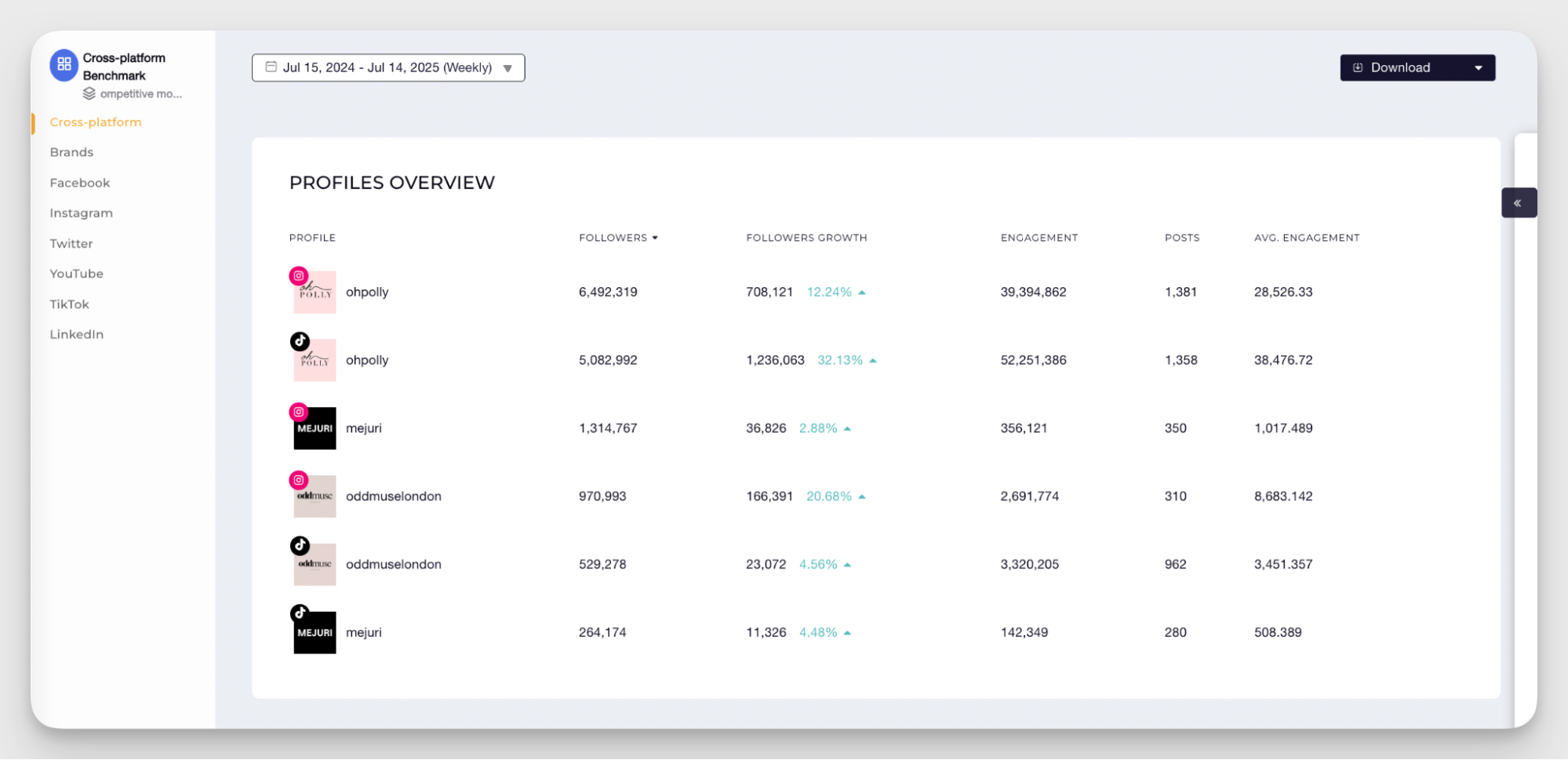
- Content strategy insights from competitor analysis - Analyzing competitor content performance reveals successful strategies and content types that resonate with your shared target audience, informing your own content strategy development.
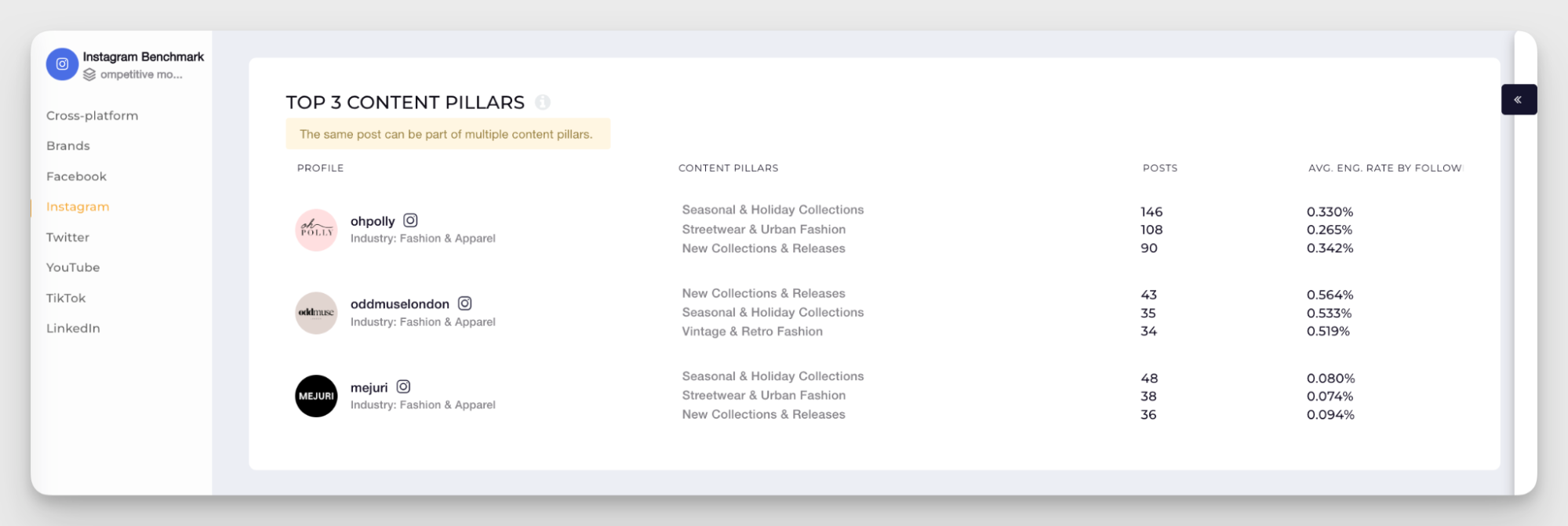
Both at a channel-level analysis and across channels for specific brands, this intelligence provides actionable insights for strategic planning and competitive positioning.
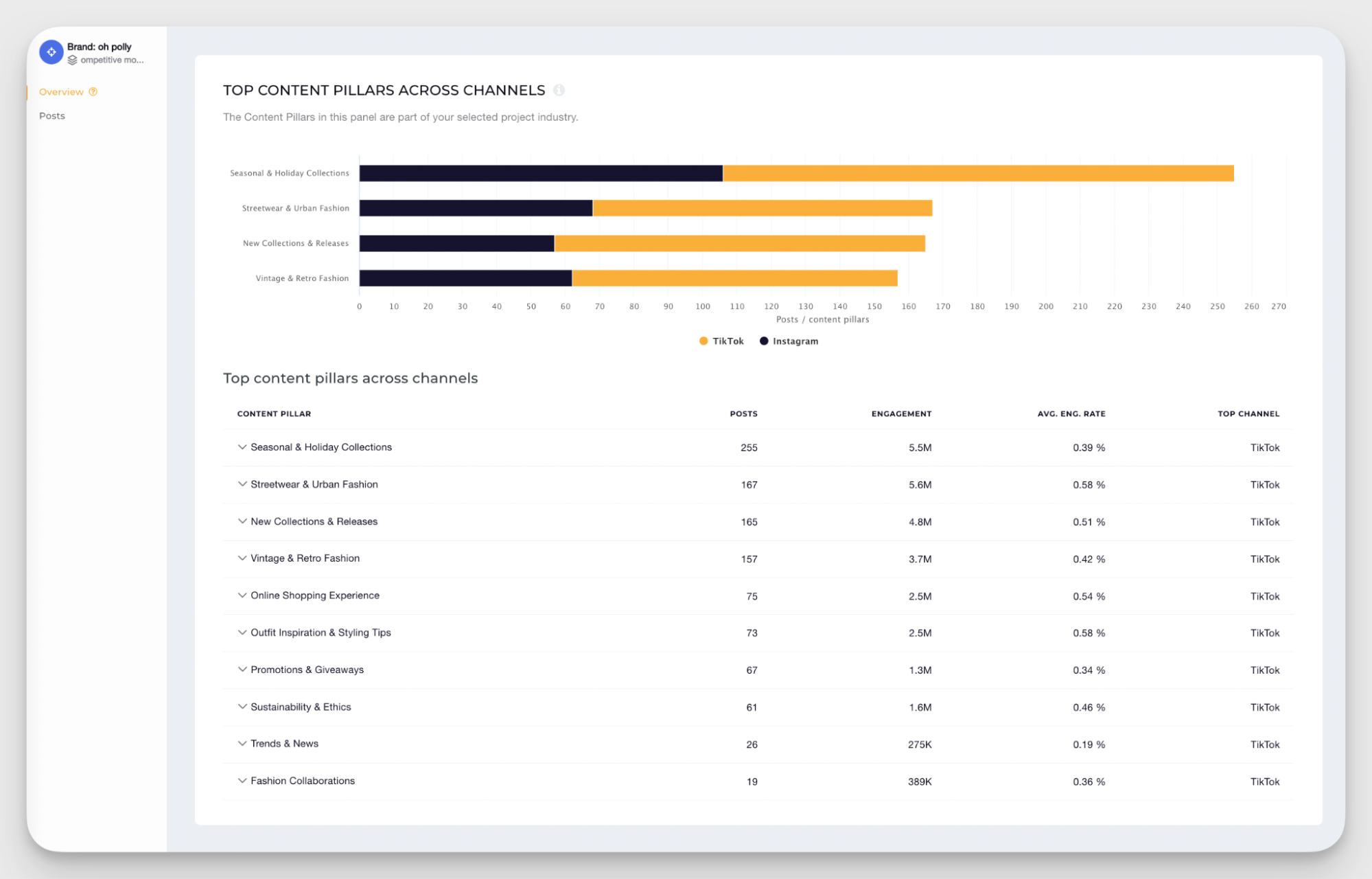
Data integration and business intelligence
When social data integrates seamlessly with broader business intelligence systems, you can truly harness the power of analytics. This integration enables you to understand social media's impact on the entire customer journey and to make data-driven marketing decisions.
- Connecting social data to business outcomes - Enterprise analytics must integrate with existing business intelligence systems through tools like social media API or platforms like Looker Studio that enable comprehensive reporting and analysis across all business functions.
- Customer journey mapping and attribution - To understand how social media contributes to customer acquisition, you need sophisticated attribution models. For example, at Socialinsider, we track this by asking customers after they purchase a subscription how they heard about the platform, providing direct attribution data for business decision-making.

- Predictive analytics and trend identification - Advanced analytics platforms enable enterprises to identify trends and predict performance based on historical data patterns, supporting proactive strategy development rather than reactive optimization.
Final thoughts
Enterprise social media success comes from mastering the balance between creativity and operational discipline.
When teams have the right structure, workflows, and technology in place, they can confidently deliver consistent brand experiences, meet compliance requirements, and prove social’s contribution to bottom-line growth.
With a clear strategy and data-driven execution, enterprises can transform social media from a marketing function into a key driver of global brand influence and customer engagement.
Analyze your competitors in seconds
Track & analyze your competitors and get top social media metrics and more!
You might also like
Improve your social media strategy with Socialinsider!
Use in-depth data to measure your social accounts’ performance, analyze competitors, and gain insights to improve your strategy.





